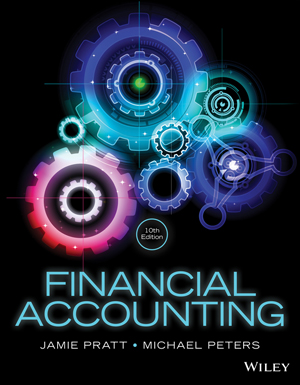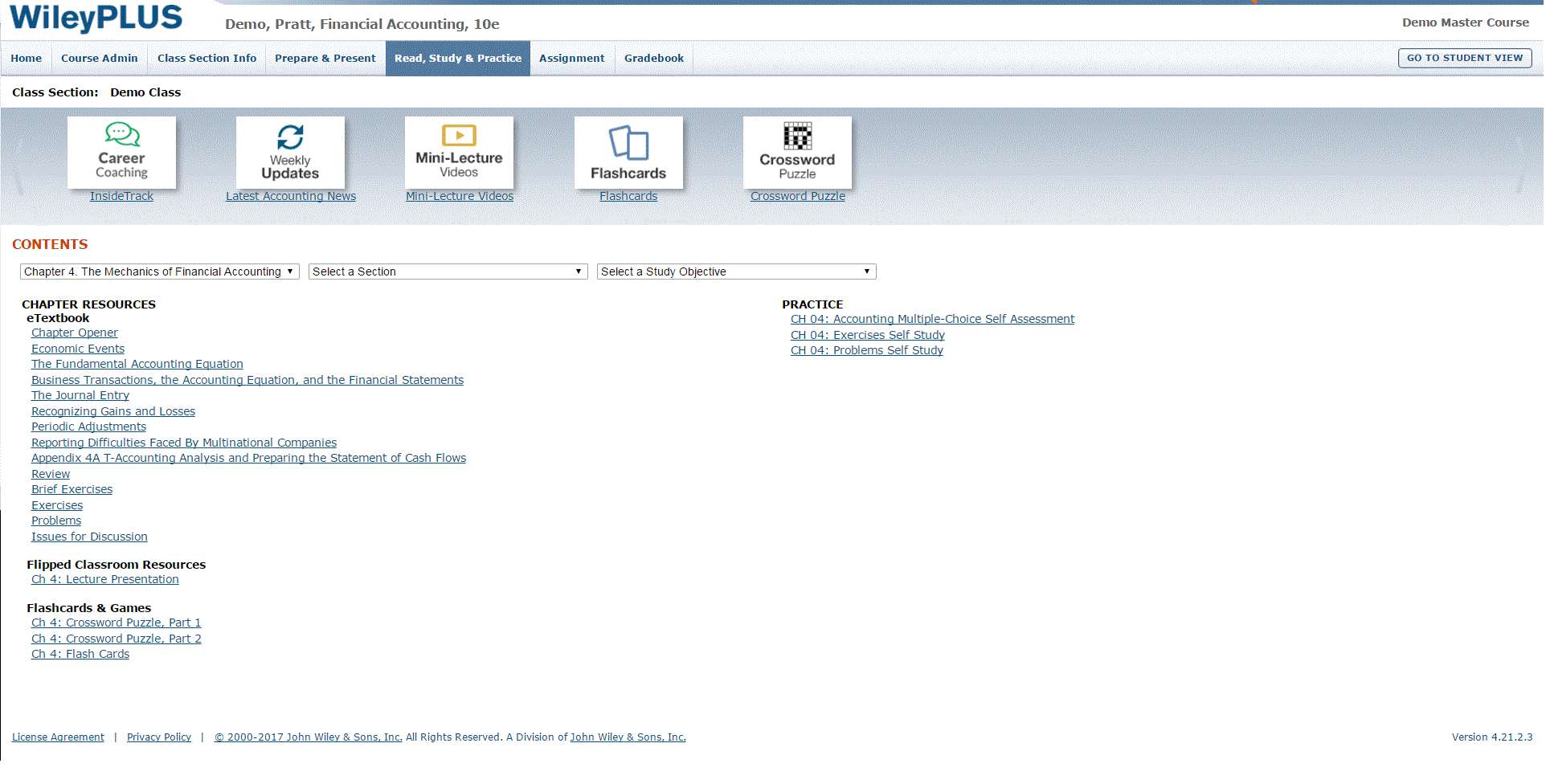
Financial Accounting, 10th Edition
By Jamie Pratt and Michael Peters
Ideally suited for financial accounting courses at the MBA and undergraduate levels, Financial Accounting, 10th Edition provides students with a clear understanding of financial accounting by framing accounting processes in the context of real-world business practices. This resource helps students build a solid foundation in the mechanics of preparing financial statements and explores key themes of measurement, decision making, and economic factors. The statement of cash flows, fair market value accounting, IFRS, and the idea of viewing financial statements as a package are additional topics of discussion integrated throughout the text.
Financial Accounting is now available with WileyPLUS, the online environment for effective teaching and learning.
Schedule a Demo Request Instructor AccountWant to learn more about WileyPLUS? Click Here

Online learning platform helps instructors and students succeed.
WileyPLUS identifies learning trends early, organizes learning to show connections between assessment and learning content, and monitors progress to develop work ethic and reasoning skills. WileyPLUS also provides students with unique study strategies, tools, and support based on learning styles for success. Instructors can now assign end-of-chapter questions, test bank questions, and new multiple-choice practice questions all in WileyPLUS.
New Lecture Videos let students review material and reinforce skills.
Mini-Lecture Videos created by author Jamie Pratt are based on the chapter material as well as lectures and class sessions that are linked to the learning objectives of the chapter.
New Concept Practice Problems and Solutions help build problem-solving skills.
Each learning objective in each chapter concludes with a review problem and accompanying solution.
- Solution Walkthrough Videos: Students are guided step-by-step through solutions to problems that are similar to the problems they will find in their homework assignments.
- Learning-Objective Driven Modules: Each chapter now opens with a chapter outline that identifies a set of learning objectives for the chapter.
- Four-Color Design: Content is now presented in vibrant full-color to enhance learning.
- Updated Content: Chapter 2 was rewritten around a scenario that derives the nature of financial statements from the perspective of an entrepreneur trying to raise capital to start a new business. Other chapters were modified to further develop the idea that financial statements should be viewed as a package, not as individual statements.
- Focus on Financial Statements: Chapter 5 has been updated in a manner that asks students to look at financial statements as a whole, rather than individually.
- Real-World Company Scenarios: Examples and questions as well as all IFRS discussions and questions have all been thoroughly updated.
- Investments and Capital Lease Updates: Effective December 2017, investments in equity securities will no longer be classified as available-for-sale on trading securities. Chapter 8 (Investments) and Chapter 11 (Leases) have been updated to reflect this change.
Features Include

Jamie Pratt is Alva L. Prickett Chair of Accounting at the Kelley School of Business in Indiana University. He received his doctoral degree from Indiana in 1977 and has held faculty positions at the University of Washington (Seattle), University of Zurich, Northwestern University, and INSEAD, returning to Indiana in 1991. He served as chair of the Accounting Department from 1998–2004 and chair of Graduate Accounting Programs from 2006–2007. He teaches financial accounting and financial statement analysis at both the undergraduate and graduate levels, and he has received teaching awards at each of the institutions listed above. In addition, he has taught in executive education programs all over the world. His research interests primarily include financial reporting and auditing issues, and he publishes frequently in the top academic accounting journals, including The Accounting Review, Journal of Accounting Research, Contemporary Accounting Research, Accounting, Organizations & Society, Auditing: a Journal of Practice and Theory as well as journals devoted to educational issues such as Issues in Accounting Education and Journal of Accounting Education. He has served as Associate Editor of The Accounting Review, program chair for the American Accounting Association (AAA) annual meeting, and he has received a number of AAA awards and recognitions. Professor Pratt was sole author of a popular textbook through 9 editions (Financial Accounting in an Economic Context), and co-authored another textbook (Financial Reporting for Managers: a Value Creation Perspective). He has also been involved in the creation of a number of other educational materials, including mini-lecture videos, casebooks, spreadsheet exercises, and state-of-the-art interactive CD-ROM products. Parents of three grown boys, he and his wife Kathy live in Bloomington, Indiana, where he enjoys sports, landscaping, and playing the piano.

Michael Peters is the Chair and Alvin A. Clay Professor of Accountancy at the Villanova School of Business. Prior to Villanova University, he was an assistant professor at the University of Maryland-College Park. He received his Ph.D. in accounting from Indiana University. Prior to his doctoral work, he graduated with a degree in accounting from Michigan State University and an MBA in finance from Indiana University. He was previously a Certified Public Accountant in the states of Michigan and Maryland. Professor Peters has work experience in public accounting after his undergraduate degree and commercial banking after his MBA degree. Professor Peters has taught financial accounting at the executive MBA, MBA, MAC, and undergraduate levels at Villanova University. He has been noted in BusinessWeek as an outstanding faculty for his MBA teaching at the University of Maryland–College Park and has also received various teaching awards. His research interests are in financial reporting and auditing along with educational issues. He’s published in the top accounting academic journals such as The Accounting Review, Contemporary Accounting Research, Auditing: A Journal of Practice and Theory, and educational journals such as Issues in Accounting Education. He lives in Devon, Pennsylvania, with his wife Jeannine and two children.
Part 1: An Overview of Financial Accounting
Chapter 1: Financial Accounting and its Economic Context
Chapter 2: A Closer Look at the Financial Statements
Part 2: Measurement, Mechanics, and Use of Financial Statements
Chapter 3: The Measurement Fundamentals of Financial Accounting
Chapter 4: The Mechanics of Financial Accounting
Chapter 5: Using Financial Statement Information
Part 3: Assets: A Closer Look
Chapter 6: The Current Asset Classification, Cash, and Accounts Receivable
Chapter 7: Merchandise Inventory
Chapter 8: Investments in Equity Securities
Chapter 9: Long-Lived Assets
Part 4: Liabilities and Stockholder’s Equity: A Closer Look
Chapter 10: Introduction to Liabilities: Economic Consequences, Current Liabilities, and Contingencies
Chapter 11: Long-Term Liabilities: Notes, Bonds, and Leases
Chapter 12: Shareholders’ Equity
Part 5: Income and Flows
Chapter 13: The Complete Income Statement
Chapter 14: The Statement of Cash Flows
Appendix Z: The Time Value of Money
Appendix B: Quality of Earnings Cases: A Comprehensive Review

